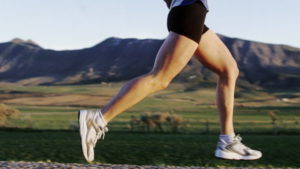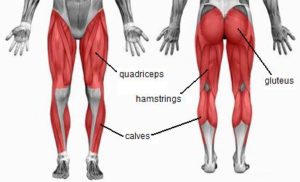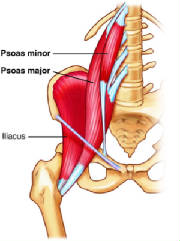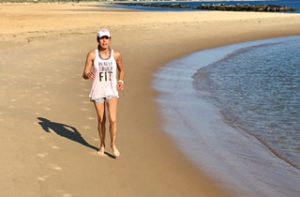That’s right .. “Holy” hip pain because pain is often our most divine teacher. This is what I’ve learned.
“Pain is inevitable, Suffering is optional” – Buddha
Needless to say, I was shocked to find that I was having hip pain after my recent pilgrimage to India. I was feeling incredible mentally and emotionally and felt that I had done a lot of personal “healing” through meditation and self-study. I came back home ready to live my life with my new perspective. As a physically active person, I was really ready to jump right back into my workout routines and yoga asana classes, committed (once again) to regular practice. For the most part during my trip to India, there was very little movement (108 degree days), and a lot of sitting and most of the yoga asana practices were very gentle.
Unfortunately, once home, every time I tried to run, I had this nagging hip pain that wrapped around my upper thigh, and by nagging I mean it stopped me in my tracks. Walking on the beach, I noticed the same nagging pain. Flow classes – same. Ugh!!
With some new introspective tools from my Yoga pilgrimage to India, I have learned a lot about my body mechanics and my coping mechanisms. As any athletic person will attest to, the worst advice you can be given is to rest.
I would stop running for a few days and try again, but there it was. What was driving me crazy, as an inquisitive physician, was that I couldn’t comprehend WHY I was having pain. For god’s sake, I had done nothing to injure myself – quite the opposite, I essentially was inactive for almost 3 weeks in India. I’ve had issues with my sacroiliac joints in the past, so I got a chiropractic adjustment, which realigned the S-I joint, but the hip pain persisted. Thinking this was all tight muscles, I got several massages, which seemed to help, until I tried to run. A chiropractor thought it could be hip bursitis and an orthopedic surgeon agreed +/- Iliopsoas tendonitis. So, more rest (ugh), ice and NSAIDs. When I tried to run again, at this point a month after my return from India, pain was still there but not as intense.
Time to examine Everything I have been doing in more detail. Before I left for India, I was in pretty good shape, running regularly. I, like many runners, have chronically tight muscles – hamstrings, quads, glutes. But, I would not say that I had pain. Then I went to India and did not run for 3 weeks (108 degrees). Since I wasn’t doing very much, could it be all the sitting? Could it be how was I sitting? For lectures and meditation, I was sitting for hours on the floor or in a chair; I had also sat for hours on long flights and long bus rides. I also started to ask myself “Could it be emotional? Is this all part of my spiritual healing?”
With the help of Dr Clayton, chiropractor extraordinaire, who treats the entire musculoskeletal system, I think I have some answers, at least on the physical plane. On top of baseline hip rotation and imbalances, prolonged sitting led to shortened and contracted muscles, which led to pain with activities. Prolonged sitting in which muscles are in a shortened state for extended periods can lead to the muscles adapting to this position. Once in an adapted state, muscles have trouble returning to their normal resting length.
This is often the case with the the Quadriceps, Hamstrings and Iliopsoas muscles. This was the case for me.
The iliopsoas is actually comprised of two muscles: the Psoas muscle and the Iliacus muscle. The Psoas originates from the lower spine (T12 and L1-L5) and inserts into the inner thigh. The Iliacus originates from the iliac fossa then descends to join the Psoas major tendon.
The primary function of both the Psoas and Iliacus is hip flexion, also known as flexion of the thigh. In other words, these muscles lift the knee to take a step in walking & running. Due to its attachment along the spine, the Psoas also plays a major role in maintaining upright posture.
The Hamstrings consist of three muscles in the back of the thigh, originating from the ischial tuberosity (the sit bones) and inserting into the bones of the lower leg below the knee. This large muscle mass plays a key role in knee flexion (bending the knee), extending the thigh and rotating the knee. When tight, contraction can cause the hips and pelvis to rotate back flattening the lower back and causing back problems. Tight hamstrings can also be responsible for postural problems and other back problems such as sacroiliac joint pain (thinking chicken or the egg), as they will tend to pull the pelvis out of normal position.
Consequences of Chronic Muscular Contraction
If a muscle cannot return to its normal resting length, it then resides in a state of chronic contraction and numerous undesirable consequences can result:
1. Ischemia. A state of low blood flow. An ischemic muscle is often a painful muscle.
2. Trigger Points which refer pain – felt in the affected muscle or in other parts of the body (radiated pain).
3. Distorted Movement Patterns. A chronically contracted muscle can distort the movement of the joint it crosses. For example, a chronically tight iliacus could reduce movement at the front of the hip.
4. Muscular Compensation. If a chronically tight iliacus, for example, reduces movement in one hip, then the other hip or the spine or other parts of the body will be called upon to compensate or to change their normal pattern of movement.
5. Nerve Entrapment. A chronically contracted muscle may be responsible for entrapment of nerves, another cause of pain.
So what to do? Sometimes all you need is stretching. But while in India, I was doing yoga stretches everyday. Sometimes you need more aggressive manual therapy in order to enable the muscle to fully lengthen. The reason for this is that the fibers of a muscle can become adhered or stuck together.
Sometimes this “adherence” is within the muscle itself, and sometimes one muscle can become adhered to another muscle. In both cases the attempt of the muscle to fully lengthen or fully contract is impeded. This results in a dysfunctional muscle which can be painful in and of itself, but also can result in compensatory muscle patterns throughout the body.
Once contracted, a muscle cannot lengthen on its own. The contractile units of the muscle (sarcomeres) must be stretched back to their original resting length by an outside force (such as an opposing muscle group) before the muscle is able to actively contract and relax again.
In enters ART – Active Release Therapy (and in my case Dr Clayton).
ART is a patented soft tissue system movement based manipulation technique that treats problems with muscles, tendons, ligaments, fascia and nerves. Every ART session is actually a combination of examination and treatment. The ART provider uses his or her hands to evaluate the texture, tightness and movement of muscles, fascia, tendons, ligaments and nerves. Abnormal tissues are treated by combining precisely directed tension with very specific patient movements.
Namaste





